
Edward Arrowsmith, MD, MPH, Discusses EGFR Exon 20 Insertion+ NSCLC, How Knowledge Fits Into Pathways

Edward Arrowsmith, MD, MPH, medical director for clinical pathways for OneOncology, discussed treatment challenges in EGFR Exon 20 insertion+ non-small cell lung cancer (NSCLC) and best practices in use of clinical pathways.
Edward Arrowsmith, MD, MPH, medical oncologist at Tennessee Oncology’s Chattanooga location, is medical director for clinical pathways for OneOncology. He discussed the challenges in treatment of EGFR Exon 20 insertion+ non-small cell lung cancer (NSCLC), the benefits of next-generation sequencing (NGS), and use of clinical pathways requires a team approach.
AJMC®: What are some clinical characteristics seen in individuals with EGFR mutations in non-small cell lung cancer?
Arrowsmith: The first thing I would say is that there are no pathognomonic clinical characteristics. Any patient with non-small cell lung cancer has the potential to harbor an EGFR mutation. That's why for anyone with advanced disease or with resected disease eligible for the ADAURA trial with osimertinib1, we recommend testing for EGFR and certainly for advanced disease, broad-spectrum, next-generation sequencing. That said, there are some things that make the presence of an EGFR mutation more likely. The big one is that patients who have never been a cigarette smoker or have been light smokers, usually defined as less than 10 pack-years of smoking, are much more likely to have an EGFR mutation than those who have been heavy, lifelong smokers. Women are probably more likely than men to harbor an EGFR mutation, and then patients of Asian descent also probably more likely to have an EGFR mutation than other ethnicities. There are also some findings clinically, so there's a characteristic sort of ground glass diffuse infiltrates in the lungs that are often seen with EGFR mutations rather than solid central tumors that we might see in squamous cell lung cancer or small cell lung cancer.
AJMC®: What are some unique aspects of EGFR Exon 20 insertion+ NSCLC? What makes EGFR Exon 20 insertions more difficult to treat than other EGFR mutations?
Arrowsmith: The EGFR insertion mutations in which a base pair is inserted into the DNA strand are really, in my mind, almost a separate disease from the other EGFR mutations. Both Exon 20 and the more typical or classic deletions in Exon 19 or the L858R mutation in Exon 21 cause activation of the EGF kinase and the increased ATPs activity, but they really do so in different ways. The kind of classic mutations do cause a change in the shape of that binding cleft that sort of turn on the gene and protein. The Exon 20 mutations do it in a different way. Some have described it that the deletion 19 abnormality pull open that cleft, whereas the insertions in Exon 20 sort of push open that cleft. When those Exon 20 mutations occur, the phosphate-binding loop or P-loop is pushed into that cleft and that blocks the ability of the classic tyrosine kinase inhibitors like osimertinib or gefitinib or erlotinib to get in and bind to the ATP site and block that abnormality. Those drugs bind in a noncovalent manner to the protein and that bind with that difference in the shape is sort of impossible with the Exon 20 insertion mutations. Those drugs essentially hardly work at all, certainly don't work enough to be a valid therapeutic option for those patients.
AJMC®: That makes sense. When it comes to identification of EGFR mutations in non-small cell lung cancer what are some considerations for genetic testing?
Arrowsmith: The main finding that [causes] me to recommend genetic or germline testing in patients with non-small cell lung cancer is first, finding a T790M mutation at the initial presentation. That's the classic gefitinib or erlotinib resistance mutation. When we were using those drugs as our initial therapy, we would often start patients and then find that T790M present at the time of progression. It was an on therapy resistance mutation that we would describe to patients as akin to bacterium developing resistance to an antibiotic. When you see that mutation at the initial diagnosis—where they have not been exposed to any agents that would sort of allow that clone to develop—sometimes that's a familial T790M abnormality, and it's worth testing the patient germline and perhaps family members for that. Then, not EGFR-specific, the other place we often find patients with lung cancer with germline mutations is when we are doing comprehensive genomic testing. We do find other genes. We've had an interest in non-tumor-specific clinical trials and have treated many people with BRCA mutations with lung cancer. BRCA is not in and of itself a risk factor for lung cancer in any way, but it's a common enough mutation—and lung cancer is a common enough disease—that you get that intersection of those 2 by chance. We found patients with lung cancer with Lynch syndrome and other genetic predispositions to cancer that are not risk factored through lung cancer, but we just find them in the comprehensive genomic testing. The other is that when you take a family history, you sometimes will find things that are suspicious. Frequently, the patient, [may not have something suspicious], but they have family members with colon cancer or with breast and ovarian cancer where it's suspicious for those syndromes.
AJMC®: Then what are the differences between NGS and PCR testing?
Arrowsmith: PCR [polymerase chain reaction] testing is usually testing for 1 or 2 genes, and what we recommend and the [National Comprehensive Cancer Network] recommends for lung cancer in particular, for most patients with incurable metastatic disease, is comprehensive next-generation sequencing for multiple genes so 300 or more genes. This tests for all the genes that we know of today in non-small cell lung cancer that are targetable, but it also looks for other mutations that could potentially be targets for a clinical trial—or targets for drugs that are in development. Just in the last couple of years, things like the Exon 20 mutations of EGFR or other abnormalities, the KRAS-G12C is another good example of that, where we are finding targets all the time. Having done comprehensive genomic testing allows you to go back and treat those patients appropriately, rather than having to retest and retest in kind of a piecemeal fashion. What we always say is the cost of that comprehensive testing is less than the cost of an admission. It's less about the cost of a PET scan, and we think well worth it to find the best treatment for patients with metastatic cancer.
AJMC®: That's a good point. How can clinical pathways be leveraged for rare forms of diseases that may have limited therapeutic options, such as in the EGFR Exon 20 insertion positive non-small cell lung cancer?
Arrowsmith: We think one of the core functions of a pathways program is how to make sure that busy clinicians are using the best therapy for rare diseases. Probably the biggest change over the last 10 years or so in cancer care has been splitting common diseases like lung cancer into a huge number of rare diseases, such as Exon 20 insertion mutations of the epidermal growth factor receptor in non-small cell lung cancer. At OneOncology, we have what we like to think of as kind of a dynamic pathways program, where we're both choosing what we think are our optimal therapies for patients and putting that in a PDF, but then also utilizing data analytics, ordering point of care programs to help guide clinicians to remember these rare mutations or rare diseases that there may be therapies that are particularly beneficial for those patients.
The other thing I would add is that we think that analysis of next-generation sequencing reports must be a team effort. Although I was trained to look at bone marrows during hematology fellowship, I always have a hematopathologist also look at the bone marrow slides and interpret things for me. Likewise, I always have people more trained than I am in molecular biology, genetics, and cell biology help me interpret the next-generation sequencing reports or the raw data from those reports so that we can make the best decisions for our patients. We have molecular tumor boards across OneOncology where we have both working tumor boards where we analyze prospectively, the reports that we're getting, and then also molecular educational tumor boards where we look at either new therapies or new understandings of those molecular reports and how to best use that information to treat our patients optimally.
AJMC®: That’s leveraging everybody's expertise. How do you approach incorporation of novel therapies for rare diseases such as this one into clinical pathways for care?
Arrowsmith: I would say the way we look at pathways is to be comprehensive, to include all abnormalities, including things like the Exon 20 insertion mutations. We look both at things like Exon 20 insertions where they're approved therapies currently and trying to anticipate situations where we expect therapies that might be approved or become standard down the line. In advance of the approval of 2 drugs in the last year or so for Exon 20 mutations, those were patients we were looking for identifying for clinical trials and then rolling into our pathways as standard of care when the data was mature and pointed in that direction. Something else we do is try to have educational programs as new drugs come along to educate our clinicians about these new therapies, their side effects, and the optimal use, and how it may be different in, for instance, Exon 20 mutations versus Exon 19 or 21 mutations, whether those drugs are used first-line and those for Exon 20 are generally a second-line treatment.
AJMC®: In closing, can you please provide any closing thoughts on disease management considerations for non-small cell lung cancer, [00:15:00] Exon 20 insertion that you find noteworthy to share with colleagues?
Arrowsmith: The thing that I would say that is most important in the management of these rare diseases reiterates what I said earlier, which is, try to have a system to help you find these patients, so you don't overlook them on your NGS report. We're all so busy these days. You don't want to have your system [that lets you] look at a document on your computer the moment before you walk into the patient's room and think that over the course of your career, you won't miss this kind of subtle molecular findings. Build out what works for you in your practice, a way to catch all these patients and flag their charts so that you're treating them optimally, the best therapy for the best patient at the best time. I think the use of pathways to help guide your treatment also helps with that. In this dynamic world where we seem to have 1 or 2 FDA approvals every week, to rely on a pathways team to help guide your treatment is a great way to go.
Reference
Wu YL, Tsuboi M, He J, et al for the ADAURA investigators. Osimertinib in resected EGFR-mutated non-small cell lung cancer. N Engl J Med. 2020;383(18):1711-1723. doi: 10.1056/NEJMoa2027071
Newsletter
Stay ahead of policy, cost, and value—subscribe to AJMC for expert insights at the intersection of clinical care and health economics.



























































